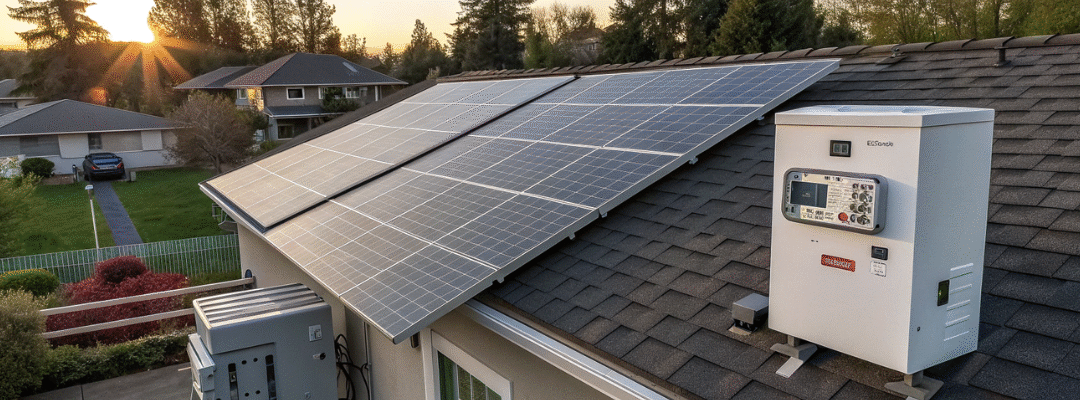Introduction: What If Your Electricity Bill Was ₹0?
With electricity costs rising steadily across India, more families are turning to solar power—not just to generate electricity, but to sell it back to the grid. That’s possible through a powerful policy mechanism called net metering.
In this post, we’ll explain what net metering is, how it works in India, how much you can save, and what you need to do to benefit from it.
What Is Net Metering?
Net metering is a billing arrangement that allows homeowners who generate electricity from rooftop solar to export excess power to the grid and get credits in return.
Here’s how it works:
- Solar panels generate electricity during the day.
- Your home uses what it needs.
- Surplus energy is sent back to the grid.
- The net meter calculates both import (from the grid) and export (to the grid).
- You pay only for the net units consumed, or get credited for excess energy.
Example:
If your system exports 100 units but imports only 90 units in a billing cycle, you are credited for 10 units, reducing or eliminating your bill.
🇮🇳 Net Metering in India: Key Highlights
- Introduced under the Electricity Act, 2003
- Mandated by most State Electricity Regulatory Commissions (SERCs)
- Applicable for residential, institutional, and commercial users
- Maximum system size varies by state (typically 1–10 kW for homes)
As of 2025:
- Most DISCOMs support bidirectional net meters
- Some states now offer gross metering as an option—but net metering is preferred for household savings
How Net Metering Saves Families Money
Real Savings Example: 5 kW System in Pune
- Monthly solar generation: ~600–700 units
- Household consumption: ~500–600 units
- Net savings: ₹5,000–₹6,500/month
- Annual savings: ₹60,000–₹78,000
- 25-year lifetime savings: ₹15–18 lakhs
Suited For:
- Households with ₹3,000–₹10,000 monthly electricity bills
- Homes with ACs, fridges, geysers, and high appliance usage
“After installing a 5 kW system with net metering, our bill dropped from ₹6,200 to just ₹110,” says Mrs. Kapoor, Delhi homeowner.
State-Wise Net Metering Policies (2025 Snapshot)
| State | Max Capacity | Net Metering Available? | Approval Time |
|---|---|---|---|
| Maharashtra | 10 kW | Yes | ~30 days |
| Delhi | 10 kW | Yes | ~15–20 days |
| Gujarat | 6 kW | Yes | ~20 days |
| Karnataka | 10 kW | Yes | ~25–30 days |
| Tamil Nadu | 10 kW | Yes | ~30 days |
Always check with your local DISCOM for current limits and formats.
How to Set Up Net Metering for Your Home
Step-by-Step Process:
- Install a rooftop solar system with an MNRE-approved vendor.
- Apply for net metering approval from your local DISCOM.
- DISCOM performs a site inspection.
- Bi-directional meter is installed and configured.
- Start generating, consuming, and exporting energy!
Important: Ensure you choose a vendor who handles net metering documentation as part of their package.
Net vs. Gross Metering: What’s Better?
| Feature | Net Metering | Gross Metering |
|---|---|---|
| Energy Used | You use solar power first | All solar goes to grid |
| Billing | Pay only for net usage | DISCOM pays you for all solar exported |
| Best For | Households aiming to reduce bills | Institutions with high rooftop space |
| ROI | Faster payback (4–6 years) | Slower ROI unless rates are high |
Verdict: For most homes, net metering = better savings + faster ROI
Policy Benefits & Protections
- DISCOMs must follow SERC guidelines
- Net metering rights are protected under national regulations
- No additional transmission charges on exported energy
- Banking of units allowed in some states (monthly or yearly)
Environmental Impact Bonus
With net metering, you’re not just saving money—you’re contributing to:
- Reduced grid load during peak hours
- Lower greenhouse gas emissions
- Helping India reach its 500 GW renewable target by 2030

